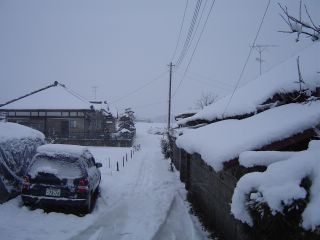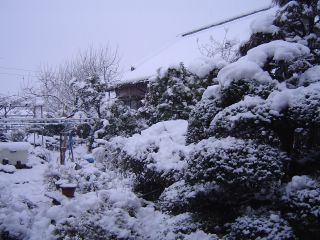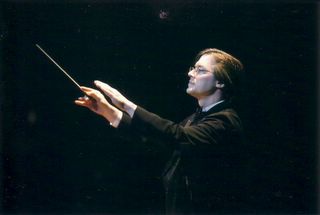Well, like the surprise snow storm, the junior high entrance exam bit is now completely over. Actually, this year's results were pretty good. The number of applicants was up. The scores were way up. Despite my rantings in that recent posting, the kids were actually more polite and well-behaved than they have tended to be in recent years. I also managed to start an argument in today's staff meeting to discuss the outcome (the only reason we had to come to work today anyway). Not bad. Not bad at all. I can almost forgive them for wiping out my whole weekend right before my birthday.

Now I and my family are sitting in our local Chinese restaurant,
Yamucha, which opened only about a year or so ago. I like it when we come here, though we don't do it very often (which helps keep it special). As I wait for our food to arrive, I can't help but think about all the Chinese friends I've made, particularly over the past couple of months.
Of course, the term "Chinese" is a very simple word for something which is actually very, very complex. The nation known as "China" includes a staggeringly wide variety of different ethnic groups and cultures. Even the so-called "Chinese language" is actually a number of very different languages that share a common root grammar structure (or, perhaps more accurately, lack thereof) and symbol-based writing system. Even more amazing is the fact that none of my rapidly-expanding circle of Chinese friends actually live in China. The one I've known best and longest, though originally from China, grew up and lives in Macao. Most of the others are from Malaysia, though they can be found in various places on the planet (if you're lucky enough to catch them, that is! ;-) ). Yes, "Chinese" is a very simple-sounding word, but it represents something that is anything but simple!
Kind of like "tea".
When I was growing up in the U.S.A., tea came in two varieties, ice and hot. Then, in my college days, I discovered that there were such things as Darjeeling, Ceylon, orange pekoe, Earl Gray, English breakfast, Irish breakfast, jasmine, and whatever other varieties Twinings, Lipton, Fortnum & Mason, or Fauchon decided to put in those little bags. I then progressed into the wonderful world of herbal tea. As a student at Oregon State University with a rapidly-expanding interest in the world beyond my own backyard, I found I far preferred tea to coffee, and I drank a lot of it.
Then, in 1987, I went on a tour of Taiwan plus a two-day stopover in Japan together with my university symphonic band. That was probably the event that first opened the door to Asia to me (especially considering I'd been concentrating on German studies with a mind to studying music in Germany at the time). It was a very eventful trip, to be sure, but among the various things I encountered, there was one thing I noticed:
The tea wasn't the color I was used to. In Taiwan it tended to be a very pale yellowish or purplish. In Japan it was most definitely green. None of it tasted like any tea I'd had in the States, though I remembered having had something similar once in a Chinese restaurant in Portland in my childhood. Not surprisingly, most of the souvenirs I brought back were packs of tea (most of which, unfortunately, either disappeared or wound up going more to friends than to myself). Later, some people I met in Taiwan during the tour sent me a pack of something called "oolong tea" as a birthday present. At the time, I had no idea what to make of it, let alone how to prepare it. Finally, Snabulus and I got brave and tried boiling some up in a pot. I had no idea what I was doing, so we improvised.
In retrospect, what we got didn't taste anything like the very nice oolong tea I'm drinking right now.
Yes, tea, like the Chinese who introduced it to the world, is a very diverse and complex thing, though it is signified in English by a simple, three-letter word that rhymes with a letter of the Roman alphabet. The Chinese character for it is 茶, read "cha" in Japanese, though using only that word with a simple honorific,
o-cha, means
green tea in the Land of the Rising Sun.


Ocha was introduced to Japan in the 12th century together with Zen, as Zen masters from China drank it as an aid in meditation. Now it is quite widespread here, though it is less ubiquitous than it used to be. A guest or customer is traditionally supposed to be greeted with a cup of it. Japanese restaurants traditionally offer a cup of green or oolong tea before and after a meal. Coffee is now becoming more common in these roles, which is a pity since green tea is rich in antioxidants, something which many experts say helps to explain why the Japanese have the world's longest average lifespan. I have heard more than one disgruntled foreigner describe ocha as "grass tea", but it is green because it is mostly if not totally unfermented (which also explains its often rather sour, "plant-like" taste). In other words, it goes almost straight from the bush and into the pack, usually with only drying in between. As simple as that may seem, there are actually a great many varieties of ocha, and they do taste different. There is also the powdered, concentrated "green tea espresso", known as maccha (抹茶), which is used in the Tea Ceremony.
 Uroncha
Uroncha, or oolong tea (烏龍茶, literally "black [crow] dragon tea",) is partly fermented and often lightly toasted, so the leaves appear a darker green, and the tea itself is usually a golden brown or reddish-brown. It has a very rich aroma and, though less having less of the sourness of many green teas, it is more bitter. It also has a stronger caffeine content. It is also rich in polyphenols. As I mentioned before, restaurants often serve it as an after-dinner drink. It is also popular in pubs and at drinking parties for people that are unable or unwilling to drink alcohol, such as designated drivers. Ironically, however, it is widely used as a mixer, particularly with the evil liquor known as
shochu (an 80-120 proof concoction made from either rice, barley, plums, parsnips, or whatever else someone can ferment and distill). I should also point out that Chinese massage therapists, particularly Taiwanese foot masseuses, use oolong tea as a very wonderful-smelling massage oil.

The tea Westerners are most familiar with is black tea, which is called
kocha (紅茶, literally "
crimson tea"!) in Japan. Easier to produce than oolong tea, kocha is toasted and thoroughly fermented, so the leaves are actually a very dark color. The tea itself, however, is usually a very deep red depending on type and strength. The more extensive fermentation means it is has an even smoother taste than oolong tea (the reason Westerners prefer it) but can be even more bitter and have an even higher caffeine content. Even in this day and age, most Japanese seem not to prefer black tea. Although it is widely drunk, it is still far less popular than green or oolong tea or coffee. That sets the Japanese apart from the Chinese, who seem to prefer black teas, especially ones flavored with fruit or fragrant oils.
Herbal tea can be found in Japan, but it has yet to really catch on. For those wanting to avoid the caffeine and bitterness of ocha, uroncha, or kocha there is also
mugicha, or barley tea. According to Chinese tradition, room-temperature barley tea is the best thirst quencher on a hot day. I don't know about the room-temperature bit, since I like my cold drinks
cold, but mugicha definitely goes down nice after a workout. It's also very good hot.
Genmaicha, or brown rice tea (quite often blended with small amounts of green tea), is also widely popular and easily found in supermarkets.
The first tea plantations in Japan were established in the 12th century by order of the Emperor (or was it the Minamoto shogunate?) in the town of Uji near Kyoto. Even today, the best Japanese tea brands still come from Uji, which is now a city but still has a lot of tea producers with all the pride, discrimination, festidiousness, and eccentricity of quality wineries (though a lot of the actual teas that they sell are grown in Shizuoka, Kagoshima, Fukui, or Hokkaido). Go to the tea section (yes, there will always be one) in any supermarket and you will find a good selection of green teas, many of which sport Uji addresses. Go to one of the many tea specialty shops, and not only will you find an even wider variety, but it's a given that the highest quality ones will all be from Uji, not to speak ill of respectable brands that come directly from Shizuoka, Kagoshima, or other tea-growing areas of the country. After all, good teas do tend to get shipped around a lot.
 A top-grade Uji ocha using tea leaves grown in Kagoshima
A top-grade Uji ocha using tea leaves grown in KagoshimaYes, tea may seem simple, but it's not. There's an awful lot more there than meets the eye (or the T), and it always has a lot of enjoyment to offer. Just like my Chinese friends.
I'm driving tonight, so no beer. That's okay. This oolong tea is really good, just like I know my dinner will be. Besides...I have beer waiting for me at home.



























